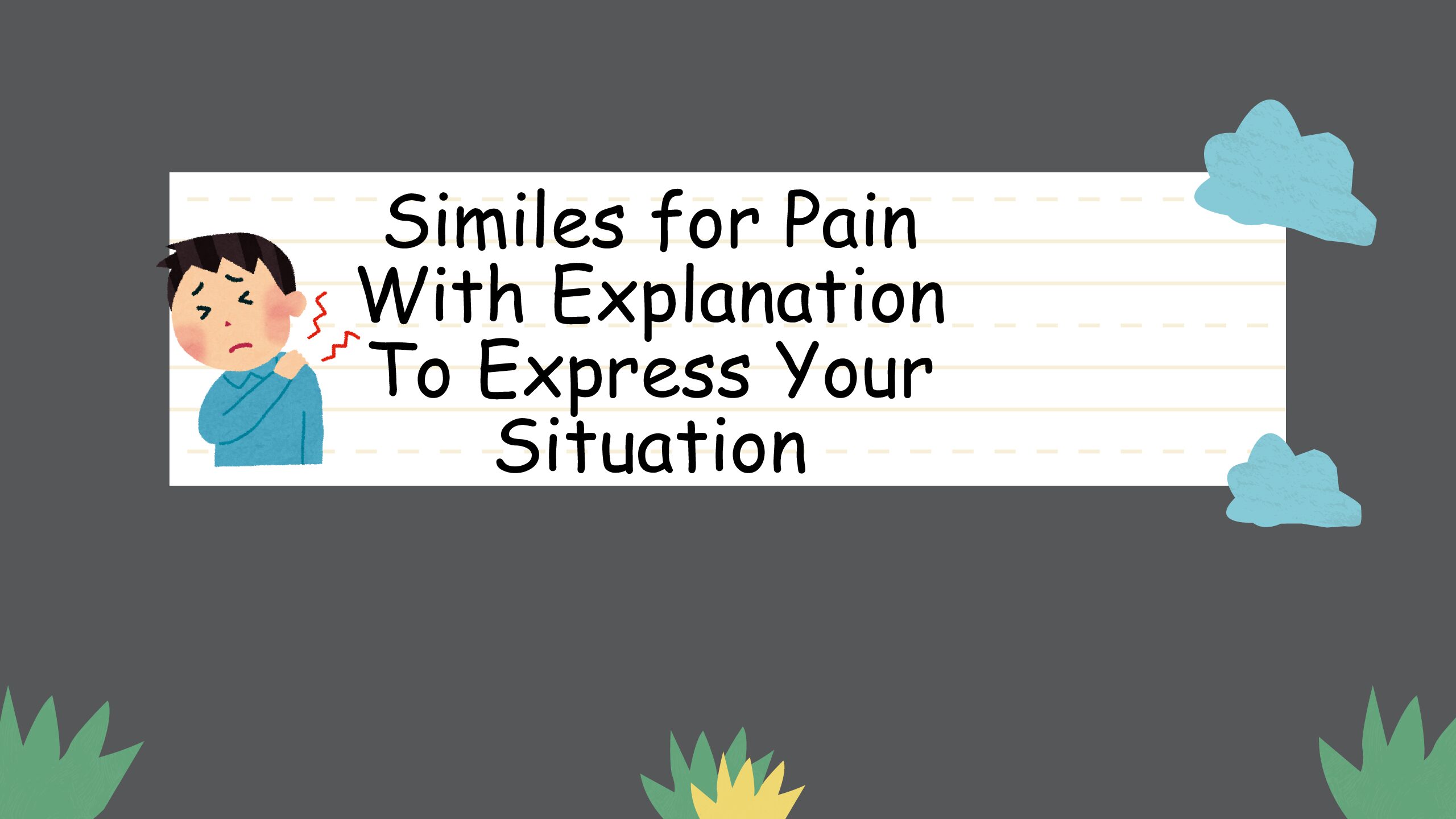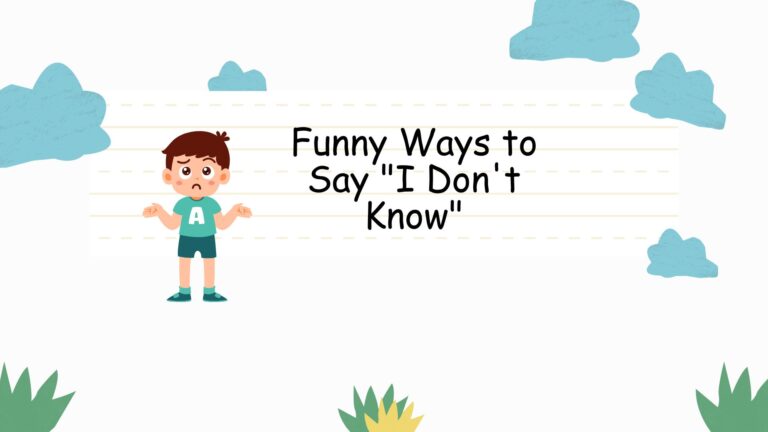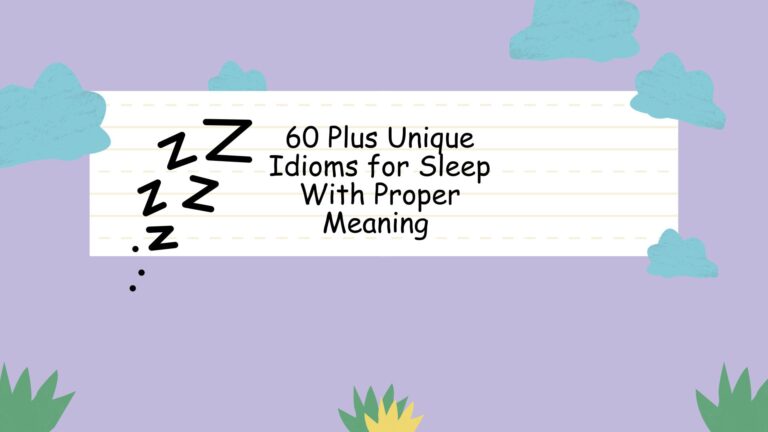
Other Ways to Say “Sorry to Hear That”: A Comprehensive Guide

Expressing sympathy is a crucial part of effective communication, especially when responding to someone’s misfortune. While “Sorry to hear that” is a common and acceptable phrase, over-reliance on it can make your responses sound repetitive or insincere. This article explores a variety of alternative phrases and expressions to convey your empathy more effectively and appropriately. Understanding these alternatives will enrich your communication skills, allowing you to provide more meaningful and personalized support. This guide is designed for English language learners, native speakers looking to expand their vocabulary, and anyone who wants to improve their ability to express condolences genuinely.
Table of Contents
- Introduction
- Definition: Expressing Sympathy
- Structural Breakdown of Sympathetic Phrases
- Types of Sympathetic Expressions
- Examples
- Usage Rules
- Common Mistakes
- Practice Exercises
- Advanced Topics
- FAQ
- Conclusion
Definition: Expressing Sympathy
Expressing sympathy is the act of showing understanding and compassion towards someone who is experiencing hardship, sorrow, or distress. It involves acknowledging their pain and offering comfort or support. It goes beyond simply acknowledging the event; it requires conveying genuine empathy and concern. Effective sympathy involves both verbal and non-verbal communication, including tone of voice, body language, and active listening. The goal is to make the person feel heard, understood, and supported during a difficult time. This can involve practical assistance, emotional support, or simply being present to listen.
Structural Breakdown of Sympathetic Phrases
Sympathetic phrases often follow a simple structure, typically including an expression of empathy, an acknowledgment of the situation, and/or an offer of support. The structure can vary depending on the specific phrase and the context of the conversation. Some phrases are direct and concise, while others are more elaborate and personalized. Understanding the common structural elements can help you create your own sympathetic responses tailored to the situation.
Here’s a breakdown of common elements:
- Expression of Emotion: This usually involves words like “I’m sorry,” “That’s terrible,” or “I’m so sad.”
- Acknowledgment of the Situation: This clarifies what you are responding to, such as “to hear about your loss” or “that you’re going through this.”
- Offer of Support: This provides practical or emotional assistance, such as “Let me know if I can help” or “I’m here for you.”
- Expression of Hope: This offers encouragement for the future, such as “I hope things get better soon” or “Stay strong.”
These elements can be combined in various ways to create a wide range of sympathetic phrases. For instance, a simple phrase might only include an expression of emotion and acknowledgment, while a more elaborate response might include all four elements.
Types of Sympathetic Expressions
There are several ways to express sympathy, each with its own nuance and appropriateness depending on the situation and your relationship with the person. Here are some common types:
Expressions of Empathy
These phrases focus on sharing the person’s feelings and acknowledging their pain. They convey that you understand what they are going through, even if you haven’t experienced the same situation. Empathy involves putting yourself in the other person’s shoes and recognizing their emotional state.
Offers of Support
These phrases offer concrete assistance or emotional support. They let the person know that you are willing to help them in any way you can. Offers of support can range from practical help, such as running errands, to emotional support, such as listening and providing encouragement. The key is to offer assistance that is genuine and within your capacity.
Acknowledging the Situation
These phrases directly address the situation and validate the person’s feelings. They show that you understand the significance of what they are going through and that you are taking their concerns seriously. Acknowledging the situation is crucial for making the person feel heard and understood.
Expressions of Hope
These phrases offer encouragement and optimism for the future. They provide a sense of hope that things will eventually get better. While it’s important not to minimize the person’s current pain, offering a gentle reminder of hope can be comforting. However, it’s important to avoid being overly optimistic or dismissive of their feelings.
General Sympathetic Statements
These are versatile phrases that can be used in a variety of situations. They express general concern and sympathy without being overly specific. General sympathetic statements are useful when you don’t know the person well or when you want to keep the conversation brief. However, it’s important to ensure that these statements still come across as genuine and sincere.
Examples
Here are some examples of alternative ways to say “Sorry to hear that,” categorized by the type of expression:
Empathy Examples
The following table provides examples of phrases that express empathy. These phrases focus on sharing the person’s feelings and acknowledging their pain. They convey that you understand what they are going through, even if you haven’t experienced the same situation.
| Phrase | Context |
|---|---|
| “I can only imagine how difficult that must be.” | Responding to news of a job loss. |
| “That sounds incredibly challenging.” | Hearing about a friend’s health struggles. |
| “I’m truly saddened to hear that.” | Learning about a death in the family. |
| “My heart goes out to you.” | Expressing sympathy for a personal tragedy. |
| “I feel for you.” | Acknowledging someone’s frustration with a difficult situation. |
| “That must be so frustrating.” | Responding to a complaint about a bureaucratic process. |
| “I’m so sorry you’re going through this.” | Offering support during a divorce. |
| “It sounds like you’re in a lot of pain.” | Acknowledging someone’s emotional distress. |
| “I understand how upsetting that must be.” | Responding to news of a theft or loss. |
| “I can’t imagine what you’re feeling right now.” | Expressing sympathy for a major life event. |
| “That’s just awful, I’m so sorry.” | Expressing sympathy for a natural disaster. |
| “I’m deeply sorry to hear of your troubles.” | Offering condolences during a difficult time. |
| “That’s heartbreaking to hear.” | Responding to a sad story. |
| “I’m really sorry that happened to you.” | Offering sympathy for a personal misfortune. |
| “I am so sorry this has happened.” | Expressing sadness and support. |
| “That’s truly terrible. I’m thinking of you.” | Expressing concern and support. |
| “I am so sorry to hear about your ordeal.” | Showing compassion for a difficult experience. |
| “I can only imagine how you must be feeling.” | Acknowledging the emotional impact of a situation. |
| “Hearing this makes me incredibly sad.” | Expressing personal sadness and empathy. |
| “I am so sorry, that sounds really tough.” | Acknowledging the difficulty of a situation. |
| “That’s awful, I’m so sorry you have to deal with this.” | Expressing sympathy for an ongoing issue. |
| “I’m truly sorry to hear about your situation.” | Showing deep sympathy. |
| “I can’t begin to imagine the pain you’re feeling.” | Expressing profound empathy. |
| “That’s devastating news; I’m so sorry.” | Reacting to particularly bad news with compassion. |
| “It breaks my heart to hear that.” | Expressing deep sorrow and empathy. |
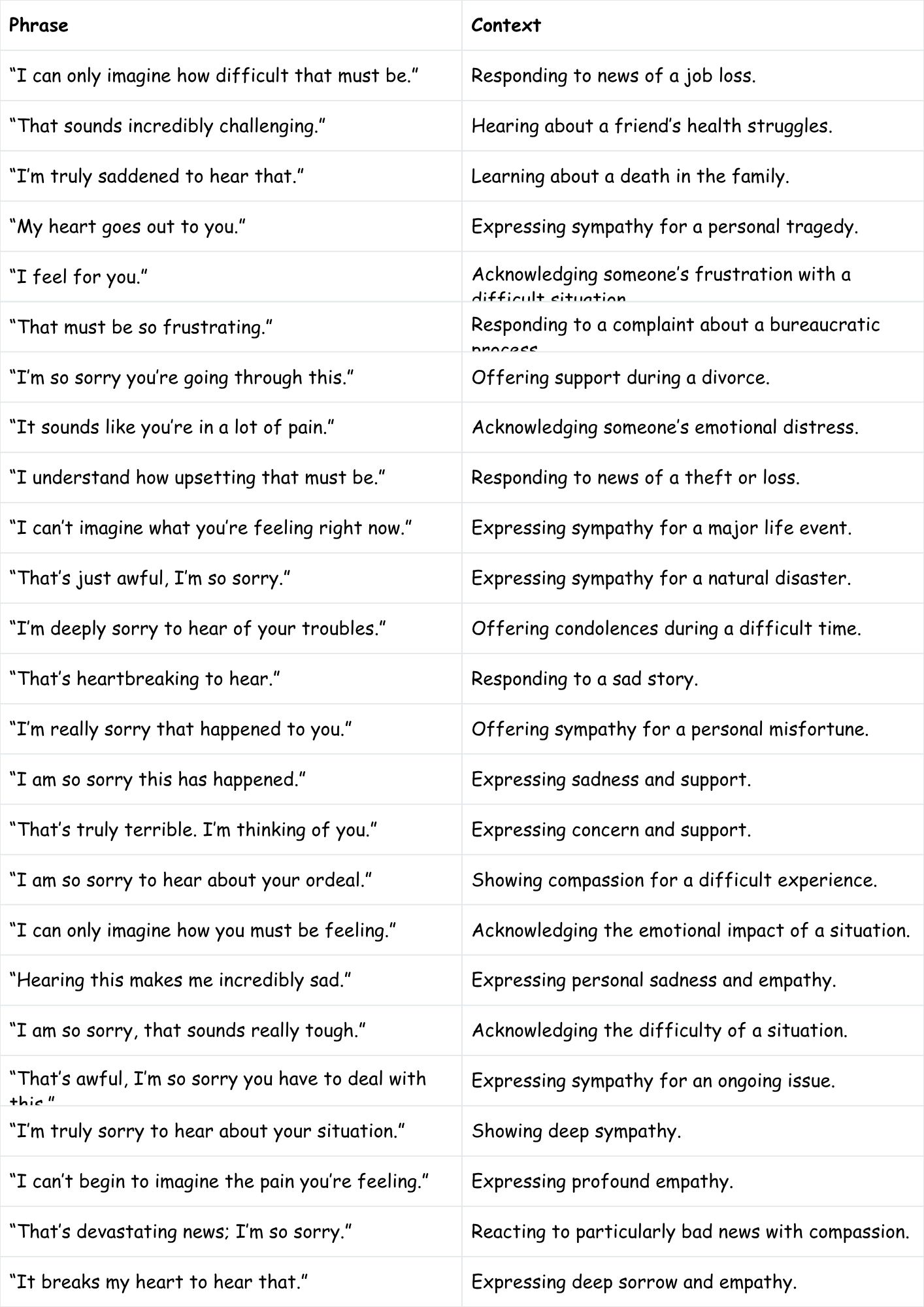
Support Examples
The following table provides examples of phrases that offer support. These phrases offer concrete assistance or emotional support. They let the person know that you are willing to help them in any way you can. Offers of support can range from practical help, such as running errands, to emotional support, such as listening and providing encouragement.
| Phrase | Context |
|---|---|
| “Is there anything I can do to help?” | Offering assistance after a loss. |
| “Let me know if you need anything at all.” | Providing general support during a difficult time. |
| “I’m here for you if you need to talk.” | Offering emotional support and a listening ear. |
| “Please don’t hesitate to reach out if you need anything.” | Encouraging someone to ask for help. |
| “I’d be happy to help with [specific task].” | Offering specific assistance, like childcare or errands. |
| “I’m thinking of you and sending positive vibes your way.” | Offering emotional support and encouragement. |
| “How can I best support you right now?” | Asking how to provide the most helpful assistance. |
| “What can I do to make things easier for you?” | Offering to lighten someone’s burden. |
| “I’m here to listen whenever you need me.” | Providing a safe space for someone to vent. |
| “Don’t hesitate to call if you want to chat.” | Offering companionship and emotional support. |
| “I’m willing to help in any way I can, just name it.” | Offering broad support and willingness to assist. |
| “If you need a shoulder to cry on, I’m here.” | Offering emotional support and a safe space. |
| “Let me know if there’s anything I can take off your plate.” | Offering to handle tasks to alleviate stress. |
| “I’m happy to run errands or help with chores.” | Offering practical assistance. |
| “Just say the word, and I’ll be there.” | Offering unwavering support. |
| “Please feel free to lean on me during this time.” | Offering emotional support and stability. |
| “I’m here to support you through thick and thin.” | Offering long-term support. |
| “Consider me a resource during this difficult period.” | Offering assistance and guidance. |
| “I’m available to help in any way possible.” | Offering open-ended assistance. |
| “Don’t hesitate to ask if you need a break or some time off.” | Suggesting self-care and offering to help facilitate it. |
| “I can bring over dinner sometime, if that would help.” | Offering practical help with meals. |
| “I’m here to help in any way, shape, or form.” | Offering comprehensive support. |
| “If you need someone to talk to, I’m all ears.” | Offering a listening ear and emotional support. |
| “I am here for you if you need anything, big or small.” | Reassuring someone that help is available for any need. |
| “I’m here to help if you need someone to listen without judgment.” | Offering non-judgmental support. |
Acknowledgment Examples
The following table provides examples of phrases that acknowledge the situation. These phrases directly address the situation and validate the person’s feelings. They show that you understand the significance of what they are going through and that you are taking their concerns seriously.
| Phrase | Context |
|---|---|
| “That’s a tough situation to be in.” | Acknowledging the difficulty of a circumstance. |
| “I can see how upsetting that would be.” | Validating someone’s emotional response. |
| “It’s understandable that you’re feeling this way.” | Normalizing someone’s emotions. |
| “That’s a lot to handle.” | Acknowledging the burden someone is carrying. |
| “I recognize how difficult this must be for you.” | Showing understanding and empathy. |
| “It’s okay to feel however you’re feeling right now.” | Giving someone permission to experience their emotions. |
| “That sounds incredibly stressful.” | Acknowledging the stress someone is under. |
| “I understand this is a really challenging time for you.” | Showing awareness of the difficulty of the situation. |
| “I know this isn’t easy for you.” | Acknowledging the person’s struggle. |
| “That’s a really difficult thing to go through.” | Validating the difficulty of an experience. |
| “I understand how much this means to you.” | Acknowledging the importance of something to someone. |
| “I realize this is a big adjustment.” | Acknowledging the challenges of change. |
| “It’s natural to feel overwhelmed in this situation.” | Normalizing feelings of being overwhelmed. |
| “I know you’re doing the best you can.” | Offering reassurance and support. |
| “That sounds like a very unfair situation.” | Acknowledging the injustice of a circumstance. |
| “I understand why you’re upset.” | Validating someone’s anger or frustration. |
| “It’s valid to feel disappointed.” | Normalizing feelings of disappointment. |
| “I know this is not what you wanted.” | Acknowledging unmet expectations. |
| “I recognize how much effort you put into this.” | Acknowledging someone’s hard work. |
| “That is a very unfortunate set of circumstances.” | Acknowledging the bad luck of a situation. |
| “I can appreciate how frustrating that must be.” | Acknowledging someone’s frustration. |
| “That’s a really tough break.” | Acknowledging bad luck or misfortune. |
| “I can see how that would affect you deeply.” | Acknowledging the emotional impact of a situation. |
| “It’s understandable why you’re feeling so stressed.” | Normalizing stress in a difficult situation. |
| “I understand that this is a profound loss.” | Acknowledging the significance of a loss. |
Hope Examples
The following table provides examples of phrases that express hope. These phrases offer encouragement and optimism for the future. They provide a sense of hope that things will eventually get better. However, it’s important to avoid being overly optimistic or dismissive of their feelings.
| Phrase | Context |
|---|---|
| “I hope things start looking up soon.” | Offering encouragement for the future. |
| “Sending you positive thoughts for a brighter tomorrow.” | Expressing hope and optimism. |
| “I’m sure things will get better with time.” | Offering reassurance and hope. |
| “Keep your chin up; brighter days are ahead.” | Encouraging someone to stay positive. |
| “I have faith that things will work out for you.” | Expressing confidence in a positive outcome. |
| “I hope you find peace and comfort soon.” | Offering hope for healing and solace. |
| “Wishing you strength and resilience during this time.” | Expressing hope for inner strength. |
| “I hope you find the support you need.” | Wishing someone well in seeking help. |
| “May things turn around for you quickly.” | Expressing a wish for a speedy recovery or improvement. |
| “I’m optimistic that you’ll get through this.” | Offering a positive outlook on a challenging situation. |
| “I hope you find a way to cope with this.” | Wishing someone strength to manage their situation. |
| “Sending you all my best wishes.” | Offering general hope and good fortune. |
| “I hope that things will fall into place soon.” | Expressing hope for resolution and order. |
| “Wishing you a speedy recovery.” | Offering hope for quick healing. |
| “I hope you find the silver lining in this situation.” | Encouraging someone to look for the positive aspects. |
| “May you find the strength to overcome this.” | Expressing hope for inner strength. |
| “I hope you find the peace you deserve.” | Wishing someone tranquility and calm. |
| “Wishing you brighter days ahead.” | Offering hope for a better future. |
| “I hope things get easier for you soon.” | Expressing hope for reduced difficulty. |
| “May you find comfort in the love of those around you.” | Offering hope for solace through relationships. |
| “I hope you can find some light in this darkness.” | Wishing someone the ability to find positivity in a negative situation. |
| “Wishing you strength to face each day.” | Offering hope for daily resilience. |
| “I hope this difficult time passes quickly.” | Expressing a wish for a short duration of hardship. |
| “May you be surrounded by support and love.” | Wishing someone a strong support system. |
| “I hope you can find some peace of mind.” | Wishing someone mental tranquility. |
General Examples
The following table provides examples of general sympathetic statements. These are versatile phrases that can be used in a variety of situations. They express general concern and sympathy without being overly specific. General sympathetic statements are useful when you don’t know the person well or when you want to keep the conversation brief.
| Phrase | Context |
|---|---|
| “That’s terrible to hear.” | Responding to bad news in a neutral setting. |
| “I’m so sorry to hear that.” | A general expression of sympathy. |
| “That’s awful.” | Expressing dismay at someone’s misfortune. |
| “Oh no, that’s dreadful.” | Expressing strong disapproval and sympathy. |
| “I’m very sorry to learn that.” | A formal expression of sympathy. |
| “That’s quite unfortunate.” | A polite expression of sympathy. |
| “What a shame.” | Expressing regret over someone’s situation. |
| “That’s a pity.” | Expressing sympathy in a mild way. |
| “I’m deeply saddened by this news.” | Expressing profound sadness and sympathy. |
| “My condolences.” | A formal expression of sympathy, often used for loss. |
| “I am so sorry for your loss.” | Specifically used for expressing sympathy for someone who has lost a loved one. |
| “That’s truly upsetting.” | Expressing genuine sadness and concern. |
| “I can’t imagine how you must feel.” | Showing empathy without claiming to fully understand. |
| “I’m thinking of you.” | Expressing care and concern. |
| “You have my deepest sympathy.” | A formal and heartfelt expression of sympathy. |
| “I’m so sorry this happened.” | Expressing regret that something bad occurred. |
| “That’s just awful news.” | Expressing strong disapproval and sympathy. |
| “This is such a difficult situation.” | Acknowledging the challenges someone is facing. |
| “That’s really tough news to hear.” | Acknowledging the difficulty of the news. |
| “I am so sorry to hear of your hardship.” | Expressing sympathy for difficult circumstances. |
| “I am so sorry to learn about this.” | Showing empathy upon hearing bad news. |
| “That’s truly dreadful.” | Expressing strong disapproval and sympathy. |
| “My heart goes out to you and your family.” | Extending sympathy to the person and their family. |
| “I’m sending you strength and comfort.” | Offering emotional support and encouragement. |
| “That’s a terrible situation to be in.” | Acknowledging the difficulty of the situation. |
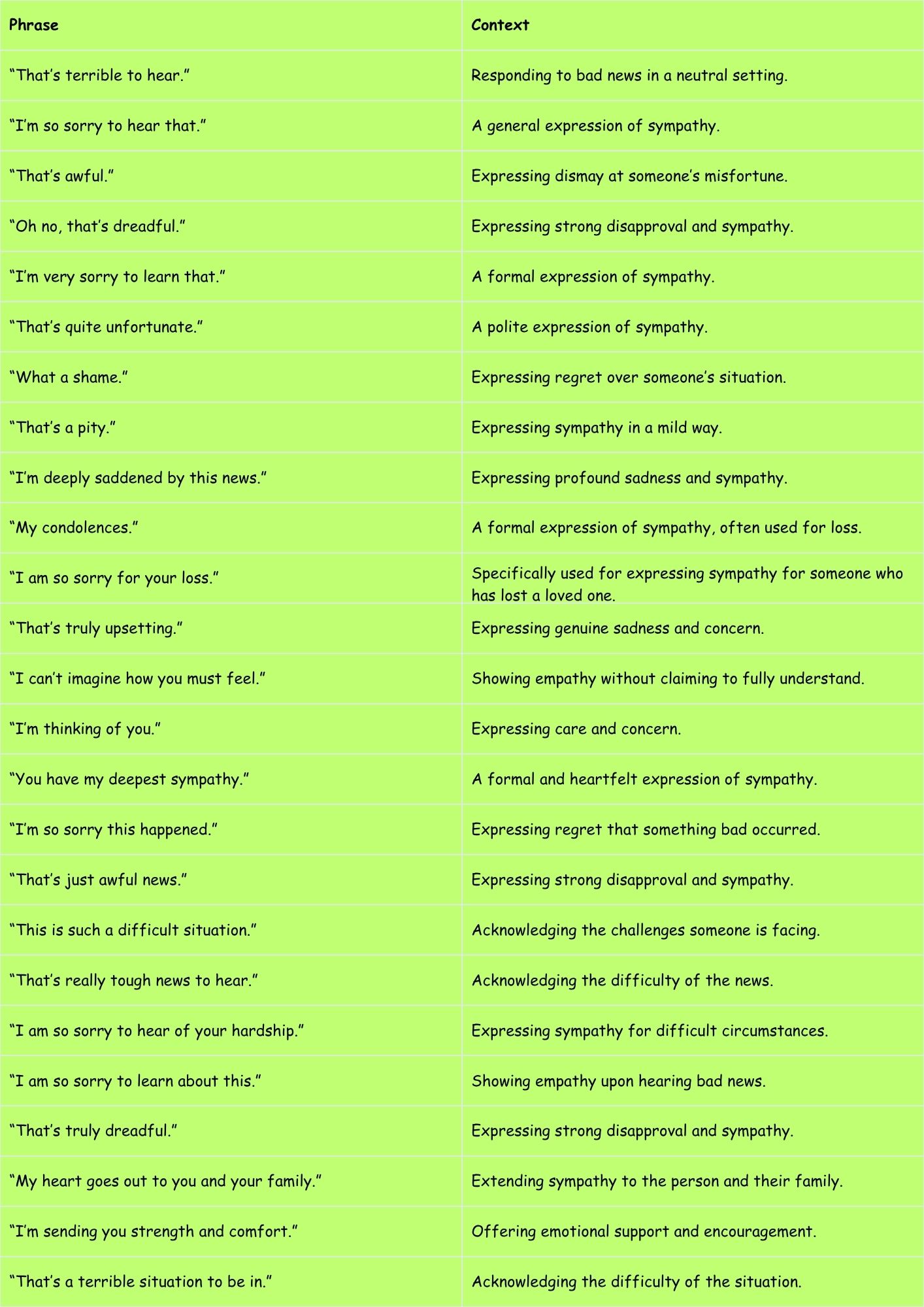
Usage Rules
While there are many ways to express sympathy, it’s important to consider the context and your relationship with the person. Here are some general rules to follow:
- Be genuine: Sincerity is key. People can often tell if you are being insincere.
- Consider your relationship: Use more formal language with people you don’t know well, and more casual language with close friends and family.
- Be mindful of the situation: Some situations call for more formal expressions of sympathy, such as a death in the family.
- Avoid minimizing their feelings: Don’t say things like “It could be worse” or “At least…” as this can invalidate their emotions.
- Focus on listening: Sometimes, the best thing you can do is simply listen and offer a supportive presence.
- Offer specific help: Instead of saying “Let me know if you need anything,” offer concrete assistance, such as “Can I help with groceries?”
- Follow their lead: If they want to talk about it, listen. If they don’t, respect their wishes.
- Avoid clichés: While some phrases are common, try to personalize your response to make it more meaningful.
Common Mistakes
Here are some common mistakes to avoid when expressing sympathy:
| Incorrect | Correct | Explanation |
|---|---|---|
| “At least you still have your health.” | “I’m so sorry to hear about your job loss. That must be incredibly stressful.” | Avoid minimizing their loss by comparing it to something else. |
| “I know exactly how you feel.” | “I can only imagine how difficult that must be.” | Unless you’ve experienced the exact same situation, it’s better to acknowledge that you can’t fully understand. |
| “Everything happens for a reason.” | “I’m here for you if you need anything at all.” | This phrase can be insensitive and unhelpful. |
| “You’ll get over it.” | “It’s okay to feel however you’re feeling right now.” | Avoid dismissing their emotions or timeline for healing. |
| “Let me tell you about my similar experience…” | “I’m so sorry you’re going through this. Is there anything I can do to help?” | Focus on the other person and their needs, not on yourself. |
| “You should…” (offering unsolicited advice) | “I’m here to listen if you want to talk about it.” | Unless they ask for advice, focus on providing support. |
| “Don’t worry, be happy!” | “That sounds incredibly challenging. I’m here if you need to vent.” | Avoid overly simplistic or dismissive statements. |
| “It’s just a…” (minimizing their loss) | “I understand how upsetting that must be.” | Avoid downplaying the significance of their experience. |
| “Get over it quickly” | “Take all the time you need to heal.” | Don’t rush the healing process. |
| “I told you so!” | “I’m sorry this happened, is there anything I can do?” | Avoid blaming the person. |
Practice Exercises
Test your understanding with these practice exercises. Choose the most appropriate response from the options provided.
| Question | Options | Answer |
|---|---|---|
| Your friend tells you they failed an important exam. | a) “It could be worse.” b) “I’m so sorry to hear that. How are you feeling?” c) “Did you even study?” | b) |
| A colleague shares that their pet passed away. | a) “Get another one.” b) “My condolences. Pets are family.” c) “It’s just an animal.” | b) |
| Your neighbor mentions they lost their job. | a) “That’s rough. Let me know if I can help with anything.” b) “At least you can relax now.” c) “I knew that company was going downhill.” | a) |
| A family member tells you they’re going through a divorce. | a) “I told you they weren’t right for you.” b) “I’m so sorry you’re going through this. I’m here for you if you need to talk.” c) “Divorce is so common these days.” | b) |
| Your acquaintance says they were robbed. | a) “That’s a pity. You should get better security.” b) “I’m so sorry that happened. Are you safe?” c) “It’s just stuff; you can replace it.” | b) |
| A friend tells you they have been diagnosed with a serious illness. | a) “Oh no, that’s dreadful. I am here for you if you need anything.” b) “It could be worse, you know.” c) “I know a great doctor who can help.” | a) |
| A coworker shares that they are struggling with a personal issue. | a) “You’ll get over it soon, don’t worry!” b) “I am so sorry to hear that. Is there anything I can do to ease your burden?” c) “That’s too bad, but we all have problems.” | b) |
| Your neighbor mentions they had a car accident. | a) “You should have been more careful.” b) “I am so sorry to learn about this. Are you okay?” c) “Cars can be replaced, don’t worry too much!” | b) |
| A colleague tells you that they missed an important deadline. | a) “That’s just awful news. Is there any way I can help you catch up?” b) “I could have told you that you wouldn’t make it!” c) “You can always try again next time.” | a) |
| A friend shares that they have to move unexpectedly. | a) “I am so sorry to hear about your hardship. Do you need any help with packing?” b) “That’s a pity, but moving is a part of life.” c) “You should have planned better!” | a) |
Advanced Topics
For advanced learners, consider the cultural nuances of expressing sympathy. Different cultures have different customs and expectations. For example, some cultures may be more direct in expressing their emotions, while others may be more reserved. Some cultures may place more emphasis on offering practical help, while others may prioritize emotional support. Understanding these cultural differences can help you avoid misunderstandings and communicate more effectively.
Additionally, explore the use of non-verbal communication when expressing sympathy. Body language, facial expressions, and tone of voice can all play a significant role in conveying your sincerity and empathy. Maintain eye contact, use a gentle tone of voice, and adopt an open and receptive posture. Be mindful of your body language and ensure that it aligns with your verbal message.
Another advanced topic is learning to navigate complex or sensitive situations. Some situations may require a more nuanced approach, such as when dealing with grief, trauma, or mental health issues. In these cases, it’s important to be extra sensitive and respectful. Avoid making assumptions or offering unsolicited advice. Focus on listening and providing support in a way that is appropriate and helpful.
FAQ
- Is “Sorry for your loss” only used for deaths?While “Sorry for your loss” is most commonly used when someone has experienced the death of a loved one, it can also be used in other situations where someone has experienced a significant loss, such as the loss of a job, a relationship, or a cherished possession. The key is to use it in situations where the person is grieving or experiencing a deep sense of sadness.
- What if I don’t know the person well?If you don’t know the person well, it’s best to keep your expression of sympathy simple and general. A phrase like “I’m so sorry to hear that” or “That’s terrible news” is appropriate. Avoid getting too personal or offering unsolicited advice. A simple acknowledgment of their situation is often sufficient.
- How do I avoid saying the wrong thing?The best way to avoid saying the wrong thing is to focus on listening and being present. Avoid making assumptions or offering unsolicited advice. If you’re unsure what to say, simply acknowledge their situation and offer your support. A phrase like “I’m here for you if you need anything” is always a safe and helpful option.
- Is it okay to offer help even if I’m not sure what to do?Yes, offering help is generally appreciated, even if you’re unsure of the best way to assist. A simple offer to listen, run errands, or provide a distraction can be helpful. The key is to be genuine and willing to adapt to the person’s needs. If they decline your offer, respect their wishes and let them know that you’re still available if they change their mind.
- What if I accidentally say something insensitive?If you accidentally say something insensitive, apologize sincerely and immediately. Acknowledge that you misspoke and that you didn’t intend to cause harm. Then, shift the focus back to the person and their needs. Avoid making excuses or getting defensive. A simple apology and a willingness to listen can go a long way in repairing the situation.
Conclusion
Expressing sympathy is an essential skill for effective communication and building strong relationships. While “Sorry to hear that” is a common and acceptable phrase, expanding your repertoire of sympathetic expressions can help you provide more meaningful and personalized support. By understanding the different types of sympathetic phrases, following usage rules, and avoiding common mistakes, you can become a more compassionate and effective communicator. Remember to be genuine, mindful of the situation, and focused on listening and providing support in a way that is appropriate and helpful. With practice and attention, you can master the art of expressing sympathy and make a positive impact on the lives of others.

